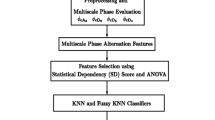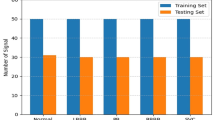Abstract
Electrocardiography is a useful diagnostic tool for various cardiovascular diseases, such as myocardial infarction (MI). An electrocardiograph (ECG) records the electrical activity of the heart, which can reflect any abnormal activity. MI recognition by visual examination of an ECG requires an expert’s interpretation and is difficult because of the short duration and small amplitude of the changes in ECG signals associated with MI. Therefore, we propose a new method for the automatic detection of MI using ECG signals. In this study, we used maximal overlap discrete wavelet transform to decompose the data, extracted the variance, inter-quartile range, Pearson correlation coefficient, Hoeffding’s D correlation coefficient and Shannon entropy of the wavelet coefficients and used the k-nearest neighbor model to detect MI. The accuracy, sensitivity and specificity of the model were 99.57%, 99.82% and 98.79%, respectively. Therefore, the system can be used in clinics to help diagnose MI.




Similar content being viewed by others
References
Vos, T., et al.: Global, regional, and national incidence, prevalence, and years lived with disability for 310 diseases and injuries, 1990–2015: a systematic analysis for the Global Burden of Disease Study 2015. Lancet 388(10053), 1545–1602 (2016)
Stuart, R., et al.: Davidson’s Principles and Practice of Medicine, 21st edn, pp. 588–599. Churchill Livingstone, London (2018)
Xingyu, Z., et al.: Atlas-based quantification of cardiac remodeling due to myocardial infarction. PLoS ONE 9(10), 1 (2014)
Guven, G., Gurkan, H., Guz, U.: Biometric identification using fingertip electrocardiogram signals. Signal Image Video Process. 12, 1–8 (2018)
Lankford, J.: The Minnesota code for ECG classification. Adaptation to CR (CH) leads and modification of the code for ECGs recorded during and after exercise. J. Intern. Med. 183(481), 13–17 (2010)
Goldberger, A.L., et al.: PhysioBank, PhysioToolkit, and PhysioNet: components of a new research resource for complex physiologic signals. Circulation 101(23), 215–220 (2000)
Bousseljot, R., Kreiseler, D., Schnabel, A.: Nutzung der EKG-Signaldatenbank CARDIODAT der PTB über das Internet. Biomed. Tech./Biomed. Eng. 40(1), 317–318 (1995)
Ingrid, D.: Ten Lectures on Wavelets, vol. 194. SIAM, Philadelphia (1992)
Singh, B.N., Tiwari, A.K.: Optimal selection of wavelet basis function applied to ECG signal denoising. Digit. Signal Process. 16(3), 275–287 (2006)
Pan, J., Tompkins, W.J., et al.: A real-time QRS detection algorithm. IEEE Trans. Biomed. Eng. 32(3), 230–236 (1985)
Percival, D.B., Mofjeld, H.O.: Analysis of subtidal coastal sea level fluctuations using wavelets. J. Am. Stat. Assoc. 92(439), 868–880 (1997)
Martis, R.J., Acharya, U.R., Min, L.C.: ECG beat classification using PCA, LDA, ICA and discrete wavelet transform. Biomed. Signal Process. 8(5), 437–448 (2013)
Hoeffding, W., Robbins, H.: The central limit theorem for dependent random variables. Duke Math. J. 15(3), 773–780 (1948)
Shannon, C.: A mathematical theory of communication. Bell Syst. Tech. J. 27(4), 623–656 (1948)
Maharaj, E.A., Andrses, M.A.: Discriminant analysis of multivariate time series: application to diagnosis based on ECG signals. Comput. Stat. Data Anal. 70, 67–87 (2014)
Duda, R.O., Peter, E.H., David, G.S.: Pattern Classification, pp. 177–191. Wiley, Hoboken (2007)
Hoeffding, W.: A non-parametric test of independence. Ann. Math. Stat. 19(4), 546–557 (1948)
Sun, L., et al.: ECG analysis using multiple instance learning for myocardial infarction detection. IEEE Trans. Biomed. Eng. 59(12), 3348–3356 (2012)
Correa, R., Arini, P.D., Correa, L.S., Valentinuzzi, M.E., Laciar, E.: New VCG and ECG indexes for early identification of acute myocardial infarction patients. In: VI Latin American Congress on Biomedical Engineering CLAIB 2014 (2014)
Banerjee, S., Mitra, M.: Application of cross wavelet transform for ECG pattern analysis and classification. IEEE Trans. Instrum. Meas. 63(2), 326–333 (2014)
Bhaskar, N.A.: Performance analysis of support vector machine and neural networks in detection of myocardial infarction. Procedia Comput. Sci. 46, 20–30 (2015)
Bin, L., et al.: A novel electrocardiogram parameterization algorithm and its application in myocardial infarction detection. Comput. Biol. Med. 61, 178–184 (2015)
Sharma, L.N., et al.: Multiscale energy and eigenspace approach to detection and localization of myocardial infarction. IEEE Trans. Biomed. Eng. 62(7), 1827–2837 (2015)
Remya, R.S., et al.: Classification of myocardial infarction using multi resolution wavelet analysis of ECG. Procedia Technol. 24, 949–956 (2016)
Acharya, U.R., et al.: Automated detection and localization of myocardial infarction using electrocardiogram: a comparative study of different leads. Knowl. Based Syst. 99, 146–156 (2016)
Acharya, U.R., et al.: Automated characterization and classification of coronary artery disease and myocardial infarction by decomposition of ECG signals: a comparative study. Inf. Sci. 377, 17–29 (2017)
Acharya, U.R., et al.: Application of deep convolutional neural network for automated detection of myocardial infarction using ECG signals. Inf. Sci. 415–416, 190–198 (2017)
Mohit, K., et al.: Automated diagnosis of myocardial infarction ECG signals using sample entropy in flexible analytic wavelet transform framework. Entropy-Switz 19(9), 488 (2017)
Reasat, T., Shahnaz, C.: Detection of inferior myocardial infarction using shallow convolutional neural networks. In: 2017 IEEE Region 10 Humanitarian Technology Conference (R10-HTC), pp. 718–721 (2017)
Liu, W., et al.: Real-time multilead convolutional neural network for myocardial infarction detection. IEEE J. Biomed. Health Inform. 22(5), 1434–1444 (2017)
Sharma, L.D., Sunkaria, R.K.: Inferior myocardial infarction detection using stationary wavelet transform and machine learning approach. Signal Image Video Process. 12(2), 199–206 (2017)
Sharma, M., Tan, R.S., Acharya, U.R.: A novel automated diagnostic system for classification of myocardial infarction ECG signals using an optimal biorthogonal filter bank. Comput. Biol. Med. 102, 341–356 (2018)
Sadhukhan, D., Pal, S., Mitra, M.: Automated identification of myocardial infarction using harmonic phase distribution pattern of ECG data. IEEE Trans. Instrum. Meas. 67(10), 2303–2313 (2018)
Dionisije, S., et al.: Real-time event-driven classification technique for early detection and prevention of myocardial infarction on wearable systems. IEEE Trans. Biomed. Circuits Syst. 12(5), 982–991 (2018)
Acknowledgements
The work described in this paper is supported by the National Natural Science Foundation of China (NSFC, 81773545).
Author information
Authors and Affiliations
Contributions
ZL wrote the paper and performed experiments. JZ, YG, YC, QG and GM offered useful suggestions for the paper preparation and writing. All authors have read and approved the final manuscript.
Corresponding author
Ethics declarations
Conflict of interest
The authors declare no conflict of interest.
Additional information
Publisher's Note
Springer Nature remains neutral with regard to jurisdictional claims in published maps and institutional affiliations.
Rights and permissions
About this article
Cite this article
Lin, Z., Gao, Y., Chen, Y. et al. Automated detection of myocardial infarction using robust features extracted from 12-lead ECG. SIViP 14, 857–865 (2020). https://doi.org/10.1007/s11760-019-01617-y
Received:
Revised:
Accepted:
Published:
Issue Date:
DOI: https://doi.org/10.1007/s11760-019-01617-y




